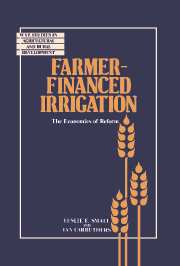Book contents
- Frontmatter
- Contents
- Preface
- 1 Irrigation financing in perspective
- Part I Analysing financing policies: theory and concepts
- 2 Key concepts from economic theory
- 3 Evaluating irrigation financing policies: a conceptual framework
- Part II Criteria for evaluating irrigation financing policies
- Part III Financial autonomy and user fees: key implementation issues
- Notes
- Index
3 - Evaluating irrigation financing policies: a conceptual framework
Published online by Cambridge University Press: 05 November 2011
- Frontmatter
- Contents
- Preface
- 1 Irrigation financing in perspective
- Part I Analysing financing policies: theory and concepts
- 2 Key concepts from economic theory
- 3 Evaluating irrigation financing policies: a conceptual framework
- Part II Criteria for evaluating irrigation financing policies
- Part III Financial autonomy and user fees: key implementation issues
- Notes
- Index
Summary
To evaluate irrigation financing policies it is necessary to consider the objectives that such policies are designed to achieve. In this chapter we examine several possible objectives that policy-makers may have for irrigation financing policies. We then attempt to identify the types of conditions that must prevail if financing policies are to have the potential to achieve these objectives. In particular, we emphasise the conditions under which financing policies may be able to promote improved irrigation performance.
To begin our discussion, however, we need a framework for categorising the various financing methods that may be used as part of an irrigation financing policy.
Methods of financing irrigation
An irrigation financing policy is simply the combination of specific funding methods that a government or agency has established to pay for irrigation services. Although many different financing methods may be found in use by governments around the world, they can be grouped into a few basic types (Fig. 3.1).
The first distinction made in Fig. 3.1 is between direct and indirect financing methods. Direct financing methods require specified beneficiaries of irrigation to make payments linked either to the use of irrigation services, or to the benefits received from the existence of the irrigation facilities. In the former case, the payments are in the form of user charges (sometimes also termed water charges, irrigation charges, or irrigation service fees), while in the latter case they are in the form of a benefit tax.
- Type
- Chapter
- Information
- Farmer-Financed IrrigationThe Economics of Reform, pp. 39 - 57Publisher: Cambridge University PressPrint publication year: 1991

